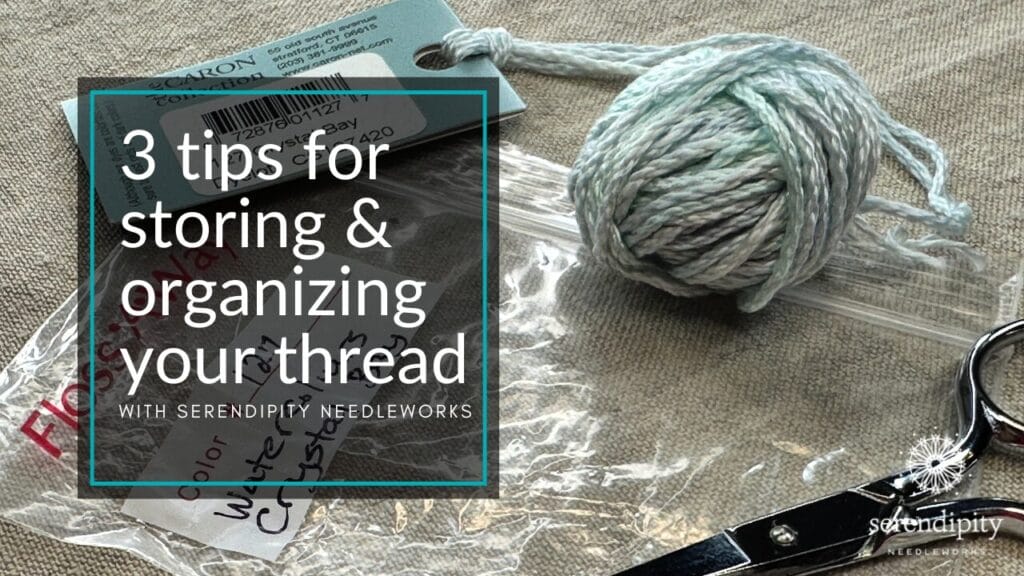I love pretty thread! In fact, I have so many different kinds of thread that I’m re-organizing them this summer so that they’re easier to access. If you’re in the boat with me, then you’re definitely going to want to keep reading because, in this blog post, I’m going to share three essential tips to help you organize and store your needlepoint threads so that they’re ready for your next needlepoint project. (And the added bonus? Keeping your workspace tidy will get those creative juices flowing so your projects will be even more fun tot stitch! 😉 )
Let’s dive in…
1. Store Your Needlepoint Thread in Clear Storage Containers
I like to be able to see my stash! That’s why I prefer using clear storage containers to organize needlepoint threads. It’s a lot easier to find the color and texture of thread that I’m looking for when I can see everything at a glance. Here are a few options for you to consider…
Clear Plastic Bins
These little beauties are incredibly versatile! They come in a variety of sizes. which enables you to store threads by color, type, or project. And if you get stackable bins, you’ll save space at the same time.
Some options are more affordable than others, but, if you keep your eyes peeled for sales, you can sometimes score some really great buys. The Container Store has an awesome selection of clear plastic bins that you can use to store your needlepoint thread, but you can find some very good options at Wal-Mart and on Amazon.com, too.

Clear Plastic Bags
For a truly budget-friendly option, consider using Floss Away bags. I store individual skeins in these little zip-top bags to keep strands from tangling. (I also keep Rainbow Gallery thread cards in Floss-Away bags so that the threads don’t unwind off the cards. 😉 )
Floss-Away bags are especially useful for storing needlepoint threads by color families. (That’s how I organize mine.) You can label each bag with the color name or number for quick identification. Store the bags in a clear plastic bin or drawer to keep everything in one place.
Transparent Drawer Units
If you have a large thread stash, transparent drawer units can be a lifesaver. These handy dandy units fit nicely on shelves and provide easy access to your threads. Each drawer can house a specific color or type of thread, making it super simple to find what you need without rummaging through piles of supplies.
2. Use a Labeling System to Organize Your Needlepoint Thread
A good labeling system can save you oodles of time – and frustration! When each thread has a “home” – and a clear label – you can quickly locate the exact shade or texture you need. Here are some labeling tips you might think about implementing…
Color Names and Numbers
Some thread manufacturers use names and numbers to identify their colors. (The Caron Collection and Weeks Dye Works are two that come to mind right away.) And others, such as DMC, use only numbers. The most important thing to keep in mind when organizing your threads with both names and numbers is to be consistent in how you label them. In other words, if you choose to label your Watercolours threads by name, it’s best to label any new additions to your stash by name, as well.
Here’s one of my skeins of Watercolours for reference…

I use a permanent marker to write on the little white squares.
Project-Based Labels
If you shop online frequently and often ask for your canvases to be “kitted” (i.e., that the threads and embellishments you’ll need to complete the piece are sent along with the canvas) , you might find it more convenient to organize (and store!) your needlepoint threads by project. This method involves storing everything you need for a specific project in one container. Be sure to label the container with the project name or a picture of the canvas, though – so you can easily identify the contents. (Voice of experience chiming in here… 😉 )
Swatch Cards
Making your own swatch cards is another terrific way to organize your threads. Create a card for each thread type and color, attaching a small snippet of the thread to the card with tape. Include the color name and/or number, as well as any other important information. Store the cards in a binder or clear box for easy reference when you need to choose new colors.
3. Manage Your Needlepoint Thread Collection Using a Rotation System
To keep your thread collection fresh – and manageable – put a rotation system to work. When you use your threads regularly, it becomes less likely that there will be any “forgotten” stray skeins at the bottom of a bag.
Wondering how a rotation system works? Keep reading for a few examples…
Seasonal Rotation
Think about rotating your threads by season. You might, for example, store bright, vibrant colors of needlepoint thread where they are easily accessible during spring and summer. Then, when the weather begins to cool, you can shift to using more muted, cozy tones for fall and winter.
This approach to organizing your needlepoint threads is especially practical if you’re a seasonal stitcher because you can group colors and textures together by application. For example, you might create storage bins based on annual holidays: Halloween, Thanksgiving, Christmas, Valentine’s Day, St. Patrick’s Day, Easter, Patriotic, etc.

“Use-By” Date
If you’ve been stitching for a while, you likely have threads that have been in your collection for several years. The best way to cycle through them is to assign them a “use-by” date. You can do that by placing those older threads in a special container and challenging yourself to use them in upcoming projects. Not only will you use those older threads, but you may even find inspiration to try new color and texture combinations.
Donate and Swap
Every so often, it’s a good idea to go through your thread stash and identify those threads you likely won’t ever use. After you organize the rest of your needlepoint threads, you can donate the “culls” to a local senior citizen center or school.
You might also consider organizing a thread swap with your stitching buddies. That way, you can “refresh” your collection without spending extra money and enjoy the added bonus of connecting with other stitchers.
Organizing and efficiently storing your needlepoint thread will, without a doubt, make stitching more enjoyable. With clear storage solutions, an effective labeling system, and a rotation method in place, you’ll be able to “shop your stash” more easily – and you might even save enough money to buy that canvas you’ve been eyeing. 😉
Plus, there’s just something about having everything in order that sparks creativity. And when your work area is neat, you’re more likely to want to stitch… YAY!!
Remember, the key to successfully organizing and storing your needlepoint thread is finding a system that works for you – and sticking to it!
Alrighty – that’s all for now, my friend…
Thank you for stopping by for a visit. If you have a tip for organizing and/or storing your needlepoint threads that you’d like to share, please put it in the comments below. I’d love to hear from you!
Until next time, happy stitching!






Hi Ellen,
I’ve decided on using peg board on the walls of my stitching room for storage so I can always see my fibers. Their organized and sitting amongst all those colors makes me so happy!
That’s a terrific idea, Tammy! Thank you for sharing it. I love being surrounded by all the pretty colors, too, and your idea for using a pegboard makes that possible for anyone. 😉
XOXO!
Ellen
How long can you keep threads? Is there a time when you should just get rid of really old ones, and how old is old? 😕😕
Some really great suggestions here. Thank you!!
Hi Bonnie!
Thank you for your kind words. You have some great questions. For starters, it depends upon how the threads have been stored. If they’ve been in a cool, dry place away from light they’ll be in much better shape than those that haven’t been in that kind of environment. The best way to tell if a thread is still usable is to test it out. First, cut off a length and then tug on it. If it doesn’t break, that’s a good sign that it’s going to be okay to use. I’d also do a color fastness test on it – especially if you’re going to be wet blocking your finished piece. You can read more about how to do that HERE.
Finally, it’s worth mentioning that natural fiber threads can last a reeeaaaallllly long time. I can’t speak to the longevity of the man-made fibers since they’re a relatively “new” invention. If you’re creating an heirloom, I’d stick with natural fiber threads. 😉
I hope this helps!
Happy stitching…
XOXO
Ellen
I found some solid colored boxes at Hobby Lobby and am able to store threads by color . I even found a gold box.
WOW! That’s so cool, Susan! Thank you for sharing that tip. Would you mind sending a picture to me at [email protected]?
I’d love to see them – and to share your tip with our readers. 😉
XOXO!
Ellen
I keep my threads in a 3″ 3 ring binder. I was able to purchase clear 3 ring pocket binders ( from Staples) I put similar colors together.
Hi Joan!
I love keeping my threads organized by color, too. I like your idea of the binder… that definitely helps with keeping things contained. 🙂
Thank you for sharing.
XOXO!
Ellen
Hi Ellen,
About a year ago, I came back to needlepoint after several years of infatuation with knitting. So much has changed in the world of needlepoint!
Thank you for storage suggestions. I had tried to store threads by mesh size – either 18 or 13 and then by color. I think that may be too complicated… so you put all threads by color only?
I spend a lot of time trying to select stitches instead of actually stitching, so I’ll keep learning from your amazing posts, TV series and blog. Thank you for sharing your knowledge about all things needlepoint!
Peggy
Hi Peggy
Thank you so much for your note. I’m delighted to know that you’re picking your needlepoint up again. I’m glad you found the storage suggestions helpful. I do organize my threads by color primarily. Within each color’s container, threads are grouped by fiber type. 😉
If you’d like to speed up the process for choosing stitches for your projects, you might check out The Stitcher’s Club. It’s my online membership for needlepointers and that’s where we explore different stitches, threads, and how to put them to use on your projects.
Please let me know if you have any questions. I’m happy to help. (You can send me an email to [email protected])
Happy stitching!
Ellen
Thank you this information today. So helpful. Have a great day.
You’re very welcome, Chris! I’m so glad you found it helpful. 🙂
XOXO
Ellen
I have a rolling cart with a large number of drawers. One drawer has the bags for threads,scissors and such. Then I have a drawer for each color i the clear floss bags labeled. The bigs on the bottom hold the books I use the most and the the top shelf is where I keep my project on the stand. It’s a life saver from a bag.
What a terrific idea, Sandi! Thank you for sharing that with us.
XOXO
Ellen